DHDD Newsletter – May/June 2023
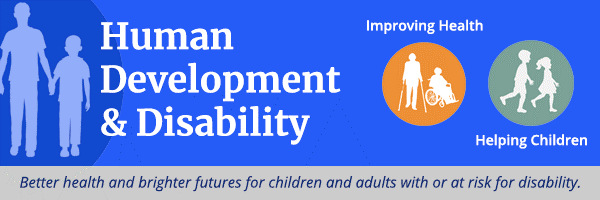
A Note from the DHDD Director
Dear DHDD Partners,
On most days, I either roll out my yoga mat or lace up my sneakers and go for a run. While the time of day I am able to exercise varies, I intentionally carve out time in my busy schedule for physical activity. I also value this time as an opportunity for reflection – I would like to share a few of my recent thoughts with you this month.

May is Mental Health Awareness Month and National Physical Fitness and Sports Month, which serve as reminders of the importance of taking care of both our physical and mental health. While physical activity may look different for different people, being active in ways that are best for us helps to optimize our health and enables us to participate in our communities. Healthy coping behaviors are also integral to the emotional, psychological, and social well-being of everyone.
However, not everyone has equal access to opportunities for good health. Policy, systems, and environmental changes are needed to facilitate physical activity and mental wellness for all. For instance, people with disabilities report more environmental barriers to being physically active than those without disabilities. In addition, people with disabilities report more frequent mental distress, demonstrating the importance of community support and adequate access to mental health care, services, and resources. Addressing these structural issues, and other ways that ableism manifests in our communities, is essential to enhance the health of people with or at risk for disability.
Whether we run, walk, or wheel or find other ways to be physically active, all of us are on our own journeys of health and well-being. As a collective, I know we are committed to going the distance to impact real change. I thank you for your ongoing commitment, and I look forward to working alongside you on the journey.
Sincerely,
Karyl
Karyl Rattay, MD, MS, FAAP
DHDD Director
In the Spotlight
Disability and Health Data System Updated with Latest Surveillance Data
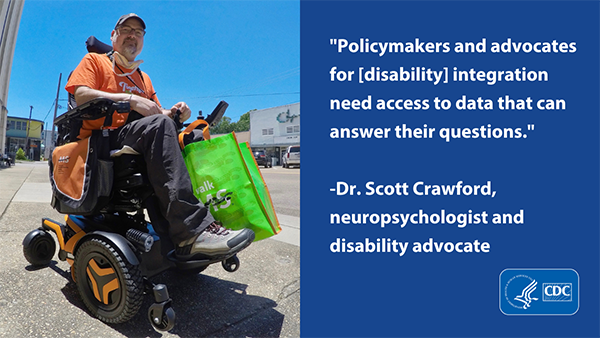
CDC’s Disability and Health Data System (DHDS) has been updated to include 2021 Behavioral Risk Factor Surveillance System (BRFSS) data. DHDS provides quick and easy access to data on demographics and health topics among adults with and without reported functional disabilities across the United States. Epidemiologists, researchers, and public health professionals can use these data to inform state and local health promotion activities to improve the health and well-being of people with disabilities.
DHDS includes BRFSS data analyzed from 2016 – 2021. Visit the Disability and Health Data System to learn about health differences between people with and without disabilities in your state and some territories.
In addition to the DHDS dashboard, CDC also has Disability & Health State Profiles that have been updated using 2021 BRFSS data. These fact sheets provide an overview of disability in each state, including the percentages and characteristics of adults with and without disabilities.
Tools and Resources
DHDD Highlights Resources for May Health Observances
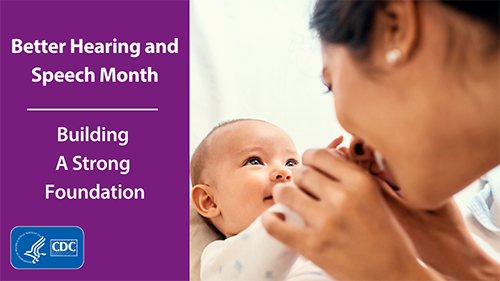
This month features several health observances that are relevant to the disability community and service providers. DHDD has published several articles online that highlight related research and resources that you may find valuable in your work. Check out the web features for information on a variety of topics for healthcare providers, public health practitioners, and parents. Retweet social media posts to help promote awareness of these valuable resources!
Better Hearing and Speech Awareness Month
Children’s Mental Health Day

National Mobility Awareness Month and Physical Fitness and Sports Month
National Provider Appreciation Day
Tourette Syndrome Awareness Month (May 15–June 15)
Clinical Trainings on Tourette Syndrome and ADHD
The American Academy of Pediatrics, with support from CDC, will host two free live webinars:
- Tourette Syndrome and Beyond: Reducing Disparities and Understanding Tic-Related Conditions
- Friday, June 2, 2023 | 1:30pm–2:30pm ET. Register for the webinar.
- Learn practical tips, knowledge, and resources to diagnose Tourette syndrome and other tic disorders, connect families and/or caregivers to needed supports and services, and identify opportunities to reduce related disparities.
- Identifying and Caring for Children and Adolescents with ADHD
- Thursday, June 15, 2023 | 12:30 pm–1:30 pm ET. Register for the webinar.
- Gain practical knowledge and resources to better identify, diagnose, and manage ADHD in children.
Both trainings will provide continuing education credits and will be recorded and available starting in August.
ADHD Podcasts for Healthcare Providers
Healthcare providers can learn about ADHD treatment, diagnosis, and related disparities and earn continuing education credits through free podcasts:
- Understanding Health Disparities and Improving the Provision of Effective ADHD Treatment in Underserved Communities
- Organization Skills Training for Children with ADHD
- Telehealth in ADHD Diagnosis and Treatment
Podcasts are offered through Children and Adults with Attention-Deficit/Hyperactivity Disorder (CHADD), with support from CDC. Access a full list of podcasts and earn continuing education credits through CDC’s Training and Continuing Education Online system or CHADD’s Training and Continuing Education on ADHD web page.
COVID-19 Resources
End of Federal COVID-19 Public Health Emergency Declaration: What You Should Know
With the end of the federal COVID-19 Public Health Emergency Declaration, CDC has shifted from an emergency response to incorporate COVID-19 activities into routine public health practice. Most tools, like vaccines, treatments, and testing, remain available. But, some tools, like certain data sources and reporting, have changed. CDC has a new web page that describes what has changed and what stays the same.
For instance, CDC’s commitment to protecting the health and well-being of people with disabilities remains the same. COVID-19 still poses a serious health risk for people with disabilities and certain medical conditions. To make sure everyone has the information they need to protect their health, CDC has developed updated COVID-19 materials in a variety of accessible formats.
Updated ASL, Braille, and Easy to Read COVID-19 Resources Now Available
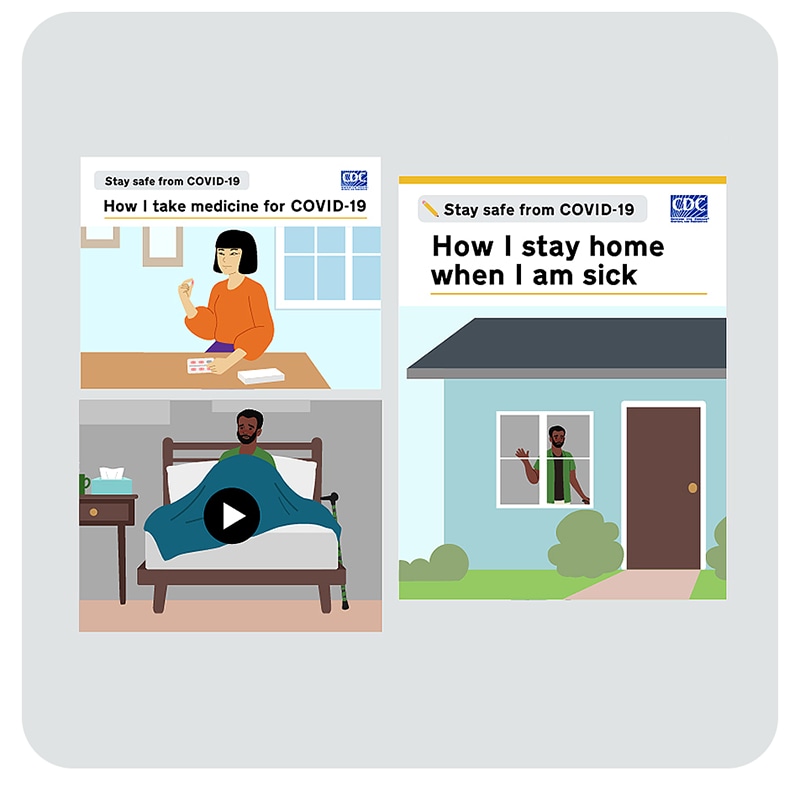
CDC’s COVID-19 Easy to Read Hub offers a suite of accessible and interactive materials for people with intellectual and developmental disabilities and their care providers. The materials on the hub are available in both English and Spanish and cover behaviors that are important to help prevent and treat COVID-19, including:
- getting COVID-19 shots
- wearing a mask
- taking an at-home COVID-19 test
- getting COVID-19 medicine
- staying home when sick
CDC’s COVID-19 ASL playlist includes ASL videos about COVID-19. The videos cover key topics, including:
- Getting vaccinated and staying up to date on COVID-19 vaccines
- Getting tested for COVID-19
- Improving ventilation
- Wearing a mask
- What to do if you or someone you know has COVID-19
CDC’s COVID-19 braille-ready files can be printed using a braille printer. The resources cover key topics, such as:
- COVID-19 vaccines for children and teens
- Getting treatment for COVID-19
- Improving ventilation in your home
- Staying safe from respiratory illnesses
- Protecting yourself and others from COVID-19
For more information on any of these products or to receive free braille-ready files, please email ICTProducts@cdc.gov.
Changes to Medicaid Enrollment and Eligibility
Federally funded programs have also returned to normal operations, and this means changes to eligibility rules for Medicaid. People with disabilities who have Medicaid coverage need to be aware of these changes and how they may be affected. The Administration for Community Living provides information for disability and aging networks to support people with disabilities in taking actions needed to maintain their health insurance coverage.
Publications
County-Level Geographic Disparities of Disabilities Among U.S. Adults, 2018
Across the United States, up to 1 in 4 adults have some type of disability based on functional limitations, including serious difficulty with hearing, vision, cognition, or mobility or any difficulty with self-care or independent living. A new study from CDC assessed differences in the county-level prevalence of these six disability types and identified county-level geographic clusters of disability prevalence across the United States. Information on the prevalence of disabilities at the local level is essential for local governments and health planners to address the needs of people with disabilities, such as health care, transportation, and other services. This is the first study to use national health survey data to describe the county-level prevalence of these six disability types.
Prevalence of Disability by Occupation Group – United States, 2016-2020
People with disabilities have job preferences similar to people without disabilities but may encounter barriers that impact the types of jobs they hold. To improve workplace health equity, CDC examined different occupation groups to identify the percentages of U.S. workers aged 18-64 years with disability. Among 22 major occupation groups, the occupation group with the highest percentage of workers with a disability was food preparation and serving (20%). The data in this report are useful for employers and workplace programs to consider increasing workplace accessibility and training to help these workers access, thrive in, and succeed at a broader range of occupations.
Parents Monitored Their Children’s Development Before and During the COVID-19 Pandemic
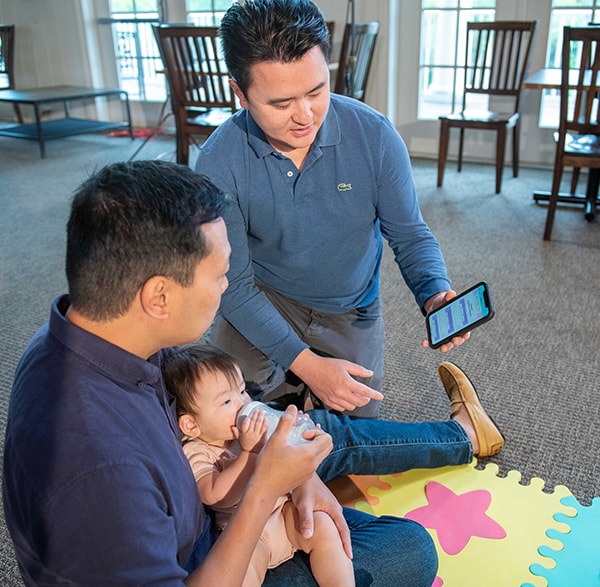
Parents know their children best. Early identification of developmental disabilities can have a significant impact on a child’s ability to learn new skills and may also reduce the need for costly interventions over time. CDC’s Learn the Signs. Act Early. program has free resources to help families monitor early development.
In a new study, CDC scientists analyzed parent survey data from Spring 2019 and Fall 2021 to understand whether parental engagement in developmental monitoring was impacted by the COVID-19 pandemic. While parental monitoring remained high (89%) both before and during the pandemic, only 29% of parents reported using publicly available developmental milestone checklists in doing so—considered a best practice in developmental monitoring. Findings suggest that continued intervention is needed to raise awareness among parents about the importance of monitoring their children’s development and available tools to aid monitoring, such as milestone checklists offered by CDC’s Learn the Signs. Act Early. program.
Emergency Department Visits Involving Mental Health Conditions Among U.S. Adolescents

Emergency department (ED) visits related to mental health, suicide behaviors, and drug overdose decreased as of late 2022, but concerns remain particularly for teenage girls. CDC examined changes in ED visits for mental health conditions, suicide-related behaviors, and drug overdoses among adolescents aged 12–17 years from January 2019 to February 2023. Compared with fall 2021, weekly ED visits for mental health conditions, suicide-related behaviors, and drug overdoses decreased overall for boys and girls ages 12-17 by fall 2022. However, these conditions and behaviors persist at high rates, especially for teenage girls. Similar to overall trends, the number of ED visits for tic disorders significantly decreased from fall 2021 to fall 2022 for both males and females, but for adolescent females they were still higher than in 2019. Implementing broad, proven prevention efforts that decrease risk and increase protection can improve the mental and behavioral health of adolescents. Identifying these conditions early and applying solutions that use what’s known about childhood trauma and stress can better support adolescents who are struggling with mental health, suicide, or substance use.
Partner News and Announcements
National Academies Seeks Public Comment on Long COVID Definition
The National Academies of Sciences, Engineering, and Medicine (NASEM) is engaged in several activities to examine the current U.S. Government’s working definition of Long COVID. As part of these activities, NASEM seeks diverse perspectives to inform revisions to the U.S. Government’s definition of Long COVID. Members of the public may submit comments to the online portal by June 12, 2023. For more information on these efforts, visit the NASEM website.

